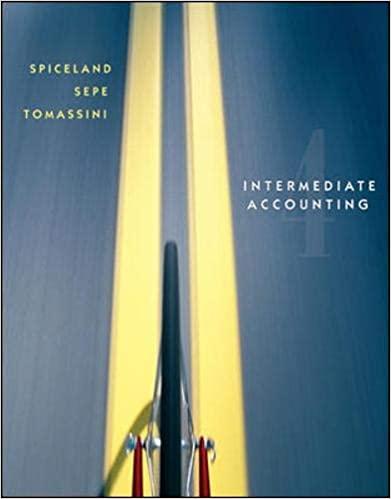Following are trial balances of Conglomerate and Sub Company as of December 31, 2014. Conglomerate Sub Cash $1,440,000 $ 120,000 Inventories 60,000 40,000 Investment in S 560,000 Building 400,000 280,000 Equipment 120,000 180,000 Accounts Payable (180,000) (120,000) Common Stock (1,800,000) (100,000) Additional Paid in Capital (250,000) (300,000) Retained Earnings (120,000) (60,000) Sales (1,100,000) (300,000) Cost of Goods Sold 700,000 200,000 Operating Expenses 170,000 60,000 Other information: Conglomerate purchased 90% of Sub Company on December 31, 2013 for $560,000. The totals above are for one year after the purchase. Differences between identifiable net assets of Sub Company on December 31, 2013 (the date of purchase) were: Fair Value Book Value Difference Building 300,000 280,000 20,000 (20 year life) Equipment 200,000 180,000 20,000 (10 year life) Goodwill created on the date of purchase was $122,222. On December 31, 2014 Sub Company paid $10,000 in dividends. Requirements: No entries have been made on either C or S?s books for dividends paid in 2014 and recording the sub?s net income on C?s books using the equity method. You must post entries to the appropriate accounts for the payment of the dividends in C?s and S?s accounts and recording the sub?s net income on C?s books using the equity method. This will change some of the balances above. . (Show entries in general journal and/or T Account format.) Prepare consolidated financial statements for the year ending December 31, 2014, using a consolidation worksheet showing the eliminations, if any. Prepare a consolidated balance sheet, income statement and statement of retained earnings.
TEMPLATE FOR UNIT 4 POST PROBLEM 2 Compute Goodwill as of date of purchase December 31, 2013 Common Stock Paid in capital Retained Earnings 12/31/2013 Market value excess - building Market value excess - equipment Net Assets at market value Net Assets at market purchased by Conglomerate Cash paid by Conglomerate for 90% Conglomerate Goodwill (90%) Total Goodwill (100%) Computation of Goodwill 100,000 300,000 60,000 20,000 20,000 500,000 90% 450,000 Computation of Sub Net Income Applicable to Parent As of December 31, 2014 Sub Sales Sub Cost of Goods Sub Op Expense 10% 50,000 560,000 110,000 122,222 90% 100% 90% 36,000 12,222 Building Equipment Building Equipment Analysis of excess amortization for first year ending December 31, 2014 Fair Value Book Value Difference Amortize 300,000 280,000 20,000 200,000 180,000 20,000 Net Life 20 year 10 year 90% Excess Amortization Investment in S 560,000 Cash XXXXXX 1,440,000 560,000 584,300 1,449,000 Equity in Subsidiary Earnings 33,300 Payment of Dividends By Subsidiary Cash 120,000 110,000 Dividend to Parent 9,000 10,000 Dividend to NCI 1,000 JOURNAL ENTRIES Debit Credit 12/31/2013 - On Conglomerate Books Investment in Sub Company Cash To record 90% interest in Sub Company 12/31/2014 - On Conglomerate Books Investment in Sub Company Eqity in sub Earnings To record 90% interest in sub income Cash Investment in Sub Company To record cash dividend paid from 90% owned subsidiary to Parent. Equity In sub earnings Investment in Sub earnings To record 90% of fair value amortizations of sub net assets. Consolidation Entry S Common Stock Additional paid in capial Retained Earnings, 12/31/2013 Investment in Sub Company @ 90% interest NCI Investment in Sub @ 10% interest To eliminate beginning stockholder's equity accounts of the subsidiary along with book value portion of investment. Dividend to NCI Consolidation Entry A Building Equipment Goodwill Investment in Sub Company NCI investment in Sub Company To recognize unamortized excess fair value as of Dec 31, 2014 and to allocate the unamortized fair value to the non controlling interest. Goodwill is attributable proportionately to controlling and noncontrolling interests. Consolidation Entry I Equity in income of Sub Investment in Sub Company To eliminate the impact of intercompany income accrued by Conglomerate. Consolidation Entry D Investment in Sub Dividends Paid To eliminate the impact of intercompany dividend payments made by the subsidiary to parent and NCI. Consolidation Entry E Amortization Expense Building Equipment To recognize excess amortization of fair value adjustments are individually recorded during the current period. Conglomerate and Sub Company Consolidated Worksheet For the year ended Dec. 31, 2014 Accounts Conglomerate INCOME STATEMENT Sales $1,100,000 Cost of Goods Sold 700,000 Operating Expenses 170,000 Amortization Expense 0 Equity in Income of Sub 33,300 Separate Company Net Income $263,300 Consolidated Net Income Non Controlling interest in Sub Income Net Income to Controlling Interest STATEMENT OF RETAINED EARNINGS Retained Earnings, 12/31//2013 $120,000 Net Income 263,300 Dividends Paid 0 Retained Earnings, 12/31/2014 $383,300 Sub $300,000 200,000 60,000 0 0 $40,000 $60,000 40,000 10,000 $90,000 BALANCE SHEET ASSETS Cash Inventories Investment in Sub Company $1,449,000 60,000 584,300 400,000 120,000 0 $2,613,300 280,000 180,000 Credit E I S D $110,000 40,000 Building Equipment Goodwill Total Assets Debit LIABILITIES AND SHAREHOLDER'S EQUITY Liabilities Accounts Payable $180,000 D S A I A A A E E $610,000 $120,000 SHAREHOLDER'S EQUITY NCI in Sub Company S A Common Stock 1,800,000 Additional Paid in Capital 250,000 Retained Earnings, 12/31/2014 383,300 Total Liabilities and Shareholder's Equity $2,613,300 Analysis of Non Controlling interest Beginning Sub net assets at book (100,000 + 300,000 + 60,000) x 10% Building excess 20,000 x 10% Equipment excess 20,000 x 10% Goodwill 122,222 x 10% Sub dividends 10,000 x 10% Excess amortization 3,000 x 10% Sub net income 40,000 x 10% 100,000 300,000 90,000 $610,000 S S Analysis of Non Controlling Interest in Subsidiary Net Income Subsidiary net income Excess amortization 10% Non Controlling Interest in subsidiary net income 64,922 3,700 Non Controlling Interest Consolidated Totals Analysis of excess amortization for first year Fair Value Book Value Difference Amortize Net Life 300,000 280,000 20,000 1,000 20 year 200,000 180,000 20,000 2,000 10 year 3,000 2,700 Excess Amortization







